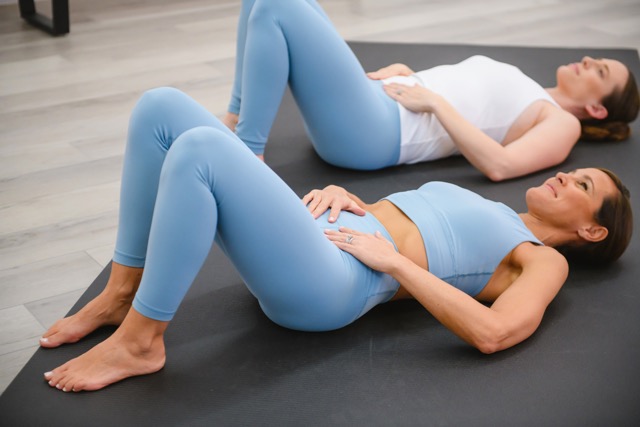
Urinary Incontinence, otherwise known as peeing your pants or loss of bladder control, is common during pregnancy and after pregnancy, especially during exercise. As many as one in three women experience urinary incontinence when exercising! 53% experience it after their 1st pregnancy. And 85% experience it after subsequent pregnancies.
If you gave birth vaginally, you might have injured nerve endings during birth – which affects your ability to control your bladder and your sphincters.
There are three ways to help urinary incontinence before considering surgery: bladder training, pelvic floor exercises and dietary changes. Before we begin those exercises, let’s determine if you do have the problem:
Do you use the restroom every 2-4 hours?
Do you use the restroom 0-1 times during the night?
Do you have normal urges? Or are you running to the restroom with urine trickling down your leg.
Does it affect your social interactions?
There are hormonal stages throughout your cycle than can affect the above questions. But most of the time you should experience the above as normal. If you have to go more frequently, get up at night more often, and if you have sudden painful urges, then chances are you have an incontinence issue.
If you do the Pelvic Floor and Kegel identification exercises below, you will be doing exactly what you need to do to work on incontinence issues. Incontinence can be brought on by stresses to your system—for example when you laugh, cough, or sneeze. The “squeeze before you sneeze method”—activating the muscles of the PF before letting go with your sneeze is an effective means of stopping leaks. Exercise can also lead to incontinence, particularly higher impact activities like step exercises, etc.
From a lying or sitting position imagine you are cutting off the flow of urine. Hold this contraction for 10 seconds. Repeat. Remember not to contract the abs, buttocks or thigh muscles. A good cue is to contract your anus. You will want to do these on an empty bladder to prevent bladder infections.
Your Pelvic Floor Muscles act as a sling from the pubic bone to tailbone. Pregnancy, childbirth and decreasing estrogen weaken these muscles. BUT these muscle fibers can be trained! Like any muscle group, you have to specifically target these muscles. You wouldn’t swim to train for a marathon right? So let’s find the correct muscles to train.
Pelvic Floor rehab – Download our Ab Rehab Guide!
Squeeze before you Sneeze: If you are about to cough, sneeze or strain it is important to pull your pelvic floor muscles up and in. Brace your muscles before sneezing and you should prevent leakage.
The Kegel exercise above is the best way to identify and isolate those muscles. Remember that in order to strengthen any muscle you have to overload it—that means that you have to work it beyond the point of its previous condition. Doing multiple sets of Kegel exercises while you are driving, sitting and watching television, eating, etc. can do wonders to help you maintain control of your bladder.
Incontinence may be affecting your life during daily activities with urges with urine leak. You can also experience stress incontinence, which is usually brought on by pregnancy and/or childbirth.
Before you consider surgical options or costly medications, be sure to try these interventions first. If you are using the correct muscles when doing the Kegel exercises and the various PF exercises than chances are you can avoid those more drastic measures. By the time you build up to doing between 50 and 100 Kegels per day, you will most likely experience improvement. There are other things you can do. Training your bladder can be as simple as scheduling toileting every 2 hours. Every other day add 30 minutes to that time. Your goal is to be able to last between 2 and 4 hours between visits.
To do this, you can use two techniques: bracing and distraction. The first involves engaging those PF muscles when you feel the urge to go. After holding for ten seconds, release. Distraction is as simple as the name implies. Find other things to think about and to do instead of heading to the bathroom. When your mind and body are actively engaged, you tend to be able to last longer. A more serious training technique involves biofeedback. Only a doctor can work with you using this technique that involves placing an electrode in the vagina. The electrode measures the intensity and duration of your Kegel contractions and helps you to gauge better how effectively you are squeezing.